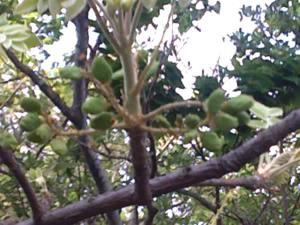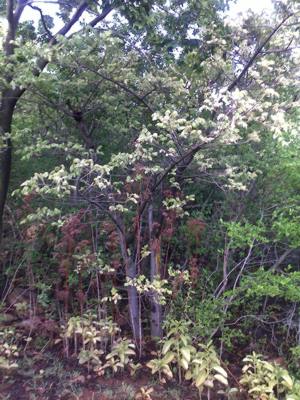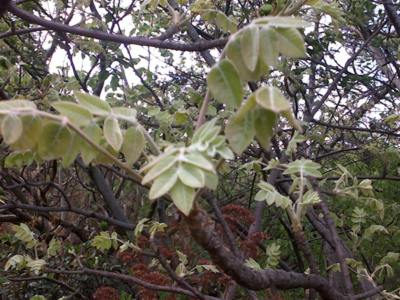Lannea discolor
Lannea discolor (Sond.) Engl.
Family: Anacardiaceae
Common names: dikbas (Afr.); live-long, tree grape (Eng.); morulamopsane, mokgôkgôthwane (Sepedi); muvhumbu (Venda)
SA Tree No: 362
Introduction
Lannea discolor is a small to medium-sized deciduous tree with a neat round crown occurring in bushveld. It is often found on rocky granite ridges.
Description
Description
The tree grape is a medium-sized deciduous tree that grows up to 15 m in height with a neat rounded crown. The bark is dark grey, roughish and cracking into small blocks which peel off. Leaves compound with up to 5 pairs of leaflets and a terminal leaflet. Leaves markedly discolorous, the upper surface green, the lower grey with dense felty hairs. Fruit are green when young, ovoid and compressed. The ripe fruits are purple and approximately 10 mm x 9 mm.

Conservation Status
Status
Lannea discolor is listed in the 2009 Red Data Listing (Raimondo et al . 2009) but has no threats status.
Distribution and habitat
Distribution description
L. discolor is widely distributed in the southern African region where it is found in South Africa (KwaZulu-Natal, Mpumalanga, Gauteng and North West), Lesotho, Swaziland, Namibia and Mozambique. It usually occurs on granite rhyolite in sandveld areas, often on rocky ridges.
Derivation of name and historical aspects
History
The name Lannea refers to the dense, woolly hairs that cover the young parts of the plants. Discolor is the Latin word for 'of different colours', referring to the contrasting colour of the upper and lower leaf surfaces.

Uses
Use
Lannea discolor is generally used as traditional medicine to treat fevers and constipation in children. Its fruits are edible and are utilized by animals, birds and humans. The wood is soft and used to make fences. Fencing poles made out of the wood will easily take root and flourish again, which has earned it its common name Live long.
Growing Lannea discolor
Grow
Lannea discolor is very easy to propagate. According to Lucy Shai, a horticulturist in our garden, the best way to grow it from seed is as follows: Clean off the outer flesh and sow the seeds immediately because they are recalcitrant and lose viability in a matter of days. Seed generally germinates in about 10 days, but this could take up to 60 days, depending on heat, water and light. If seed ripens near the end of the growing season, ensure that the young plants are kept warm during the first winter, particularly if you live in a frost zone. Prevent too much moisture, as this will certainly cause the roots to rot.
It can also be grown from cuttings or truncheons.
References
- Coates Palgrave, M. 2002. Keith Coates Palgrave Trees of southern Africa, edn 3. Struik, Cape Town.
- Grant, R. & Thomas, V.1999. Sappi tree spotting. Tree identification made easy, KwaZulu-Natal coast and Midlands. Jacana, Johannesburg.
- Palmer, E. & Pitman, N. 1972. Trees of southern Africa . Balkema, Cape Town.
- Schmidt, E., Lötter, M. & McCleland, W. 2002. Trees and shrubs of Mpumalanga and Kruger National Park. Jacana, Johannesburg.
- Van Wyk, Braam [A.E.] & P. Van Wyk, 1997. Field guide to trees of southern Africa. Struik, Cape Town.
- Van Wyk, Braam [A.E.] & P. Van Wyk, 2007. How to identify trees in southern Africa, Struik, Cape Town.
- Van Wyk, B-E. & Gericke, N. 2000. People's plants. A guide to useful plants of southern Africa. Briza Publications, Pretoria.
Credits
Thabo Masupa
Pretoria National Herbarium
November 2012
Plant Attributes:
Plant Type: Tree
SA Distribution: Gauteng, Limpopo, Mpumalanga, North West
Soil type: Sandy, Loam
Flowering season: Spring
PH: Neutral
Flower colour:
Aspect: Full Sun
Gardening skill: Easy
Special Features:
Horticultural zones










Rate this article
Article well written and informative
Rate this plant
Is this an interesting plant?
Login to add your Comment
Back to topNot registered yet? Click here to register.